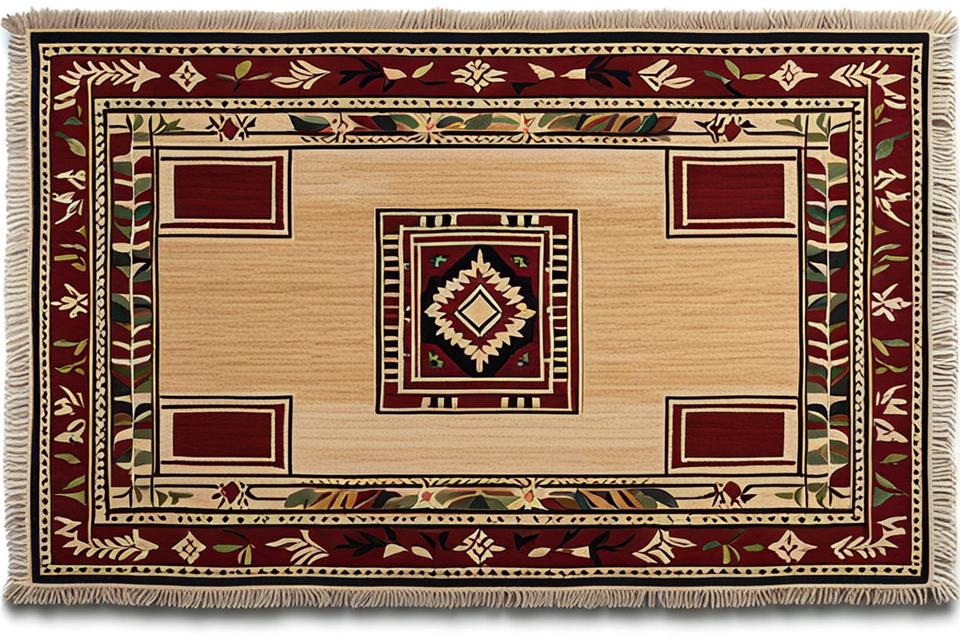Kitchen Throw Rugs - How to Pick the Perfect Size and Shape
Adding a throw rug is a great way to define spaces, absorb sound, and add comfort and style to your kitchen decor. With so many sizes, shapes, materials, and patterns available, choosing the right kitchen rug for your needs may seem overwhelming. Properly measuring your kitchen and understanding how to size rugs for the space will ensure your new accent rug not only looks fantastic, but is safe and functional.
We'll also look at recommendations for sizing rugs for popular kitchen zones like under tables, islands, and sinks. With these tips, you'll be able to beautifully incorporate throw rugs into your kitchen design.

Consider Your Kitchen Layout and Furniture
When deciding on a kitchen rug, the first step is taking measurements and making note of your existing layout. This includes the overall shape and traffic flow patterns of the space, as well as the placement of cabinets, islands, sinks, and appliances. Be sure to account for the furniture as well, including the dimensions of your kitchen table and chairs.
Pay attention to any potential clearance issues around cabinet doors and drawers, so you don't select a rug that will obstruct them. Also look at corners and hallways connecting to other rooms to ensure the rug size won't create trip hazards.
Choose Appropriate Rug Shapes
Rectangular Rugs
The most common and versatile shape, rectangular rugs are ideal for defining narrow zones in a kitchen. Their elongated shape makes them perfect to place in front of sinks, ranges, refrigerators, and other appliances. Rectangular rugs are also great for galley kitchens, providing a soft surface underfoot when moving between counters and cabinets.
When using rectangular rugs, be conscious of leaving enough bare floor around the edges so chair legs and furniture feet have a solid base, and appliance doors have room to open. They can be aligned either horizontally or vertically depending on your space.
Round Rugs
Round rugs provide a softening effect in kitchens with their curved edges and inviting shape. Placing one under a dining set anchors the furniture while allowing chairs to be pulled out and moved easily. The center clearance of round rugs also makes them ideal for open floor spaces and odd-shaped corners that may not accommodate a traditional rectangle.
Layering a round accent rug over a larger rectangular rug can create great visual interest. Just be aware of potential tripping hazards with rug-on-rug placement.
Runners
Runner rugs are long and narrow, designed to protect high traffic zones. In kitchens, they are perfect for placing in front of sinks, ranges, and countertop appliance garages to define functional areas. Runners come in a range of widths from 18 to 36 inches, working well in galley and open concept kitchens.
Extending the length of a whole workspace, a runner rug can provide anti-fatigue benefits for long periods of food prep and cooking. Just be sure to check that a standard runner width won't impede traffic flow through doorways.
Size Your Rug Correctly
Under Kitchen Tables
One of the most popular rug placements is anchoring your kitchen dining set. When sizing a rug for under a table, you'll want to leave 12-18 inches of clearance between the rug edges and table/chair legs for ease of movement.
The rug width depends on the table size and number of chairs - a good guideline is 36-48 inches wide for average 4-6 person sets. An oval or round shape often works best to provide flexibility for rearranging.
In Front of Sinks/Appliances
Runners 24-36 inches wide make great protectors in front of sinks, ranges, and refrigerators. Be sure to measure the clearance needed for appliance doors or drawers to fully open - usually an extra 12-24 inches in front is sufficient.
If you'll be standing for long periods washing dishes or cooking, consider a cushioned anti-fatigue kitchen mat for maximum comfort.
Islands
Rugs under islands look great but can also pose tripping risks if sized incorrectly. Measure the amount the island protrudes from counters or cabinets. Size your rug to about this dimension but leave some floor visible around the edges.
Rugs 4x6 ft up to 5x8 ft typically work well under standard kitchen islands depending on traffic flow. Rectangular or round shapes both complement the island shape.
Be mindful of high foot traffic areas and think about safety and accessibility needs. Allow ample clearance around doors and openings to avoid accidents.
In open concept kitchens, using more than one rug helps define cooking, dining, and lounge spaces while absorbing sound between hard floors and high ceilings.
Get creative with shaped rugs on walls, layering, and unusual pairings. Just be cautious not to create tripping or sliding risks.
Mixing rug sizes and shapes adds appealing texture and dimension to a kitchen space. Just be sure each piece has a functional purpose.
With some advance planning and measurement, selecting the perfect kitchen throw rug size and shape for your needs is straightforward. Properly sized rugs pull together your kitchen design while providing comfort and visual appeal.